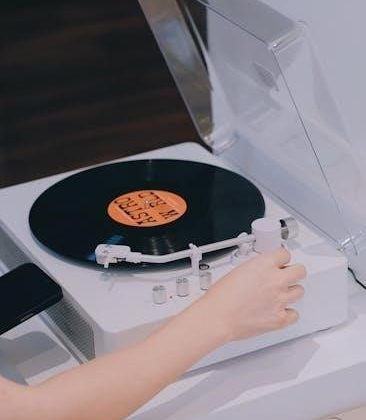A turntable cartridge is the heart of your vinyl setup‚ converting vibrations into sound. Available in Moving Magnet or Moving Coil types‚ it ensures optimal audio reproduction; Proper alignment and a phono preamp are essential for enhanced sound quality and performance.

Types of Turntable Cartridges
Turntable cartridges come in two main types: Moving Magnet (MM) and Moving Coil (MC). MM cartridges are user-friendly and widely compatible‚ while MC cartridges offer superior audio fidelity but require phono preamps for proper function.
Moving Magnet Cartridges
Moving Magnet (MM) cartridges are the most common type‚ known for their simplicity and reliability. They feature a magnetic stylus that moves within a fixed coil‚ generating an electrical signal. MM cartridges are widely compatible with standard phono inputs and require no additional equipment‚ making them a great choice for entry-level setups. They are relatively easy to install and maintain‚ with replaceable styli available for many models. MM cartridges are praised for their clear and balanced sound reproduction‚ though they may lack the high-fidelity detail of Moving Coil cartridges. Their robust design and user-friendly nature make them a popular option for both casual listeners and audiophiles alike; With proper care‚ MM cartridges can provide years of excellent performance‚ ensuring your vinyl collection sounds its best.
Moving Coil Cartridges
Moving Coil (MC) cartridges are prized for their exceptional sound quality and precision. They feature a lightweight coil and magnet assembly suspended within a magnetic field‚ ensuring accurate tracking of the record groove. MC cartridges are known for their detailed and nuanced sound reproduction‚ making them a favorite among audiophiles. However‚ they typically require a step-up transformer or a specialized phono preamp due to their lower output voltage compared to Moving Magnet cartridges. This adds complexity but enhances the listening experience. MC cartridges are more delicate and require careful handling‚ but their durability is generally good with proper maintenance. While they are often more expensive‚ the superior sound quality they deliver makes them a worthwhile investment for serious vinyl enthusiasts seeking the highest fidelity from their records.
Choosing the Right Cartridge
Selecting the ideal cartridge involves balancing sound quality‚ compatibility‚ and budget. Consider your turntable’s specifications‚ the type of records you play‚ and the desired audio performance to make an informed decision. Ensure the cartridge aligns with your system’s capabilities and enhances your overall listening experience. Proper alignment and setup are crucial for optimal sound reproduction. Research and compare different models to find the best fit for your vinyl journey and ensure longevity with proper maintenance. This careful selection will elevate your vinyl playback‚ providing years of enjoyment and faithful music reproduction. Take the time to evaluate your needs and preferences to choose the cartridge that best suits your system and listening habits. This will ensure a seamless integration and exceptional sound quality for all your records.
Compatibility with Your Turntable
Ensuring your cartridge is compatible with your turntable is crucial for optimal performance. Check the cartridge’s mount type‚ whether it’s standard or P-mount‚ to match your turntable’s headshell. The cartridge’s weight and electrical requirements must also align with your system’s capabilities. Proper alignment and balance ensure accurate tracking and prevent wear on both the cartridge and records. Additionally‚ consider the phono preamp compatibility‚ as some cartridges require specific equalization settings. Always refer to your turntable’s manual for specifications and recommendations. A compatible cartridge ensures seamless integration‚ enhances sound quality‚ and prolongs the life of your equipment. Making the right match guarantees a smooth setup process and reliable performance‚ allowing you to enjoy your vinyl collection to the fullest. This step is fundamental in achieving the best possible audio reproduction and overall satisfaction with your turntable setup. Proper compatibility ensures that every component works harmoniously‚ delivering the desired sound quality and durability. By carefully matching your cartridge to your turntable‚ you can avoid potential issues and enjoy a superior listening experience. This compatibility is key to unlocking the full potential of your vinyl playback system‚ ensuring clarity and precision in every note. Always prioritize compatibility to maintain the integrity and performance of your turntable and cartridge combination.
Sound Quality Considerations
Sound quality is a critical factor when selecting a turntable cartridge. The cartridge’s ability to accurately reproduce audio depends on its design and compatibility with your system. Moving Magnet (MM) cartridges are known for their consistent performance and ease of use‚ while Moving Coil (MC) cartridges often deliver higher fidelity but require a compatible phono preamp. The stylus shape and material also play a significant role‚ with elliptical and line-contact styli offering better tracking and detail retrieval. Additionally‚ the cartridge’s compliance and tracking force must be properly adjusted to ensure optimal sound reproduction without distortion or wear on the records; Higher-quality cartridges often feature advanced materials and precision engineering‚ resulting in clearer‚ more nuanced sound. Balancing these factors ensures a rich and immersive listening experience‚ making sound quality considerations essential for vinyl enthusiasts seeking the best possible audio performance from their turntable setup.
Budget and Cost Implications
When selecting a turntable cartridge‚ budget plays a significant role. Entry-level cartridges are affordable‚ offering decent performance for casual listeners‚ while high-end models provide superior sound quality but at a higher cost. It’s essential to balance your budget with your listening habits and system requirements. Consider whether the cartridge includes a stylus or if it’s sold separately‚ as this affects the total cost. Additionally‚ some cartridges may require a specific phono preamp‚ adding to the overall expense. While cheaper options may seem appealing‚ they might lack durability or sound clarity. Investing in a mid-range cartridge often strikes a balance between quality and affordability. Set a budget and prioritize features that matter most to you‚ ensuring your purchase aligns with your audio goals without overspending. Properly allocating resources ensures you get the best value for your money and enjoy a satisfying listening experience.

Installation of the Cartridge
Installing a turntable cartridge requires careful handling and alignment. Secure the cartridge to the headshell using screws‚ ensuring proper alignment with the gauge. Gently tighten and test playback for optimal performance.
Tools and Equipment Needed
To install a turntable cartridge‚ you’ll need a few essential tools and equipment. Start with a small Phillips head screwdriver to secure the cartridge to the headshell. An alignment gauge or tool is crucial for proper cartridge alignment‚ ensuring optimal sound quality. A phono preamp may be necessary if your turntable or receiver doesn’t have one built-in‚ to amplify the low-level audio signal. Additionally‚ a soft-bristled brush can help clean the stylus and cartridge‚ removing dust and debris. Optionally‚ an Allen wrench might be needed for adjusting or tightening certain parts of the headshell or tonearm. Always refer to your turntable’s manual for specific requirements‚ as some models may need specialized tools. Gathering these items beforehand will make the installation process smoother and more efficient.
Step-by-Step Installation Guide
Installing a turntable cartridge involves careful steps to ensure proper function and sound quality. Start by removing the old cartridge from the headshell‚ taking care not to touch the stylus. Next‚ handle the new cartridge by the body to avoid damage and gently insert it into the headshell‚ aligning the pins with the terminals. Secure it firmly using the screws provided‚ ensuring it’s snug but not over-tightened. Connect the wires to the appropriate terminals‚ matching the color coding if available. Once installed‚ use an alignment gauge to adjust the cartridge’s position for optimal tracking. Finally‚ set the tracking force according to the manufacturer’s specifications and test the setup by playing a record. Proper installation ensures clear sound and prevents wear on your records and stylus.
Setting Up Your Cartridge
Proper cartridge setup ensures optimal sound quality. Align the cartridge using a gauge‚ adjust tracking force‚ and set anti-skate to prevent wear and distortion. Regular checks maintain performance.
Cartridge Alignment Techniques
Proper cartridge alignment is crucial for optimal sound quality and record wear prevention. Use an alignment protractor or gauge to ensure the cartridge is square to the headshell. Aligning the stylus tip with the grid lines on the gauge ensures even tracking across the record groove. Misalignment can cause uneven wear‚ distortion‚ and skipping. Start by loosening the cartridge screws‚ then gently adjust the cartridge body until it aligns with the reference lines. Tighten the screws securely after alignment. Regular checks and adjustments maintain performance and extend the life of both the cartridge and your records. This simple step ensures your turntable delivers the best possible sound quality consistently.
Adjusting Tracking Force
Adjusting the tracking force ensures the stylus tracks the groove accurately‚ preventing distortion and wear. Use a tracking force gauge to measure and set the recommended force‚ typically between 1-3 grams. Start by balancing the tonearm by adjusting the counterweight. Gently rotate the dial until the arm floats evenly. Then‚ fine-tune the force by turning the weight until the gauge matches the cartridge’s specified range. Proper force ensures clear highs‚ tight bass‚ and minimal record wear. Over or under force can cause mis-tracking or stylus damage. Regular checks maintain optimal performance and extend cartridge life. Always refer to your cartridge’s manual for specific recommendations. Correct tracking force is essential for enjoying your vinyl collection with fidelity and longevity.
Setting Anti-Skate Adjustment
Anti-skate adjustment ensures the tonearm moves smoothly across the record‚ preventing the stylus from skating inward or outward. Proper adjustment reduces distortion and wear on both the stylus and record. Start by setting the tracking force‚ then adjust the anti-skate dial while playing a record with a blank or silent groove. The goal is to achieve even tonearm balance‚ with no pull to either side. Use a tracking force gauge to ensure accuracy. If the arm drifts inward‚ increase the anti-skate; if it drifts outward‚ decrease it. Fine-tune until the arm floats evenly. This adjustment ensures optimal playback and minimizes potential damage. Regular checks are recommended to maintain performance. Always refer to your turntable’s manual for specific instructions‚ as mechanisms vary. Correct anti-skate adjustment enhances sound quality and prolongs the life of your cartridge and records.

Maintenance Tips
Regular cleaning and proper alignment ensure optimal performance. Check the stylus for dust and debris‚ and adjust the cartridge as needed for consistent sound quality and longevity.
Cleaning the Stylus
Cleaning the stylus is crucial for maintaining sound quality and extending cartridge life. Use a soft‚ dry brush to gently remove dust and debris. For tougher residue‚ apply a specialized cleaning solution to a cotton swab and lightly wipe the stylus tip. Avoid harsh chemicals or excessive moisture‚ as they can damage the cartridge. Regular cleaning ensures optimal trackability and reduces wear on your records. Always handle the stylus carefully to prevent accidental damage. By incorporating this simple maintenance routine‚ you can enjoy clearer sound and prolong the lifespan of your turntable cartridge. Consistency is key to preserving your vinyl listening experience.
Checking for Wear and Tear
Regularly inspecting your turntable cartridge for wear and tear is essential to ensure optimal performance. Visually examine the stylus tip for signs of damage‚ such as uneven wear or visible chips. Check the cantilever for proper alignment and flexibility. If the cartridge body appears loose‚ tighten the screws gently but firmly. Over time‚ the stylus may wear down‚ leading to distorted sound or skipping. Replace the cartridge if you notice significant degradation or if it no longer tracks records accurately. Most cartridges have a lifespan of 500 to 1‚000 hours of playtime. Use a magnifying glass or jeweler’s loupe for a closer look. Addressing wear promptly prevents further damage to both the cartridge and your records. Always refer to your cartridge’s manual for specific maintenance recommendations. By staying proactive‚ you can ensure consistent sound quality and extend the life of your equipment. Regular checks are vital for vinyl enthusiasts.

Troubleshooting Common Issues
Identify and resolve issues like distortion‚ skipping‚ or low volume by checking connections‚ stylus cleanliness‚ and alignment. Adjust tracking force and anti-skate for optimal performance and sound quality.
Common Problems and Solutions
Common issues with turntable cartridges include distortion‚ skipping‚ and low volume. Distortion can often be resolved by ensuring proper alignment and cleaning the stylus. Skipping may result from incorrect tracking force or a worn-out needle. Low volume might indicate a connectivity issue or a faulty phono preamp. Regular maintenance‚ such as cleaning the stylus and checking connections‚ can prevent many of these problems. Adjusting the anti-skate and tracking force can also improve performance. If issues persist‚ consider replacing the cartridge or stylus. Always refer to your turntable’s manual for specific troubleshooting steps tailored to your model. Addressing these problems promptly ensures optimal sound quality and extends the life of your cartridge.
Addressing Distortion and Skipping
Digital distortion and skipping are common issues that can disrupt your vinyl listening experience. Distortion often arises from improper cartridge alignment or a worn stylus‚ while skipping may be caused by insufficient tracking force or debris on the record. To address distortion‚ ensure the cartridge is properly aligned and clean the stylus regularly. For skipping‚ adjust the tracking force to the recommended level and inspect the record for dust or scratches. If the issue persists‚ check the phono preamp settings and ensure the turntable is placed on a stable‚ level surface. Cleaning the record with a high-quality brush and using an anti-static cleaner can also help. Replacing a worn stylus or upgrading to a better cartridge may be necessary in severe cases. Regular maintenance and proper setup are key to minimizing these problems and enjoying smooth playback.
Selecting and maintaining the right turntable cartridge enhances your vinyl experience. Proper alignment‚ phono preamp setup‚ and regular cleaning ensure optimal sound quality. Invest wisely for lasting enjoyment.
Final Thoughts and Recommendations
Investing in a high-quality turntable cartridge is crucial for an exceptional vinyl listening experience. Whether you choose a Moving Magnet or Moving Coil model‚ ensure it aligns with your turntable’s specifications. Regular maintenance‚ such as cleaning the stylus and checking for wear‚ will extend the cartridge’s lifespan. Additionally‚ consider the importance of proper alignment and tracking force to prevent record damage and distortion. For optimal sound quality‚ pair your cartridge with a suitable phono preamp. Lastly‚ research and consult with experts to make an informed decision tailored to your setup and budget. By following these guidelines‚ you’ll enjoy precise sound reproduction and lasting satisfaction from your vinyl collection.
